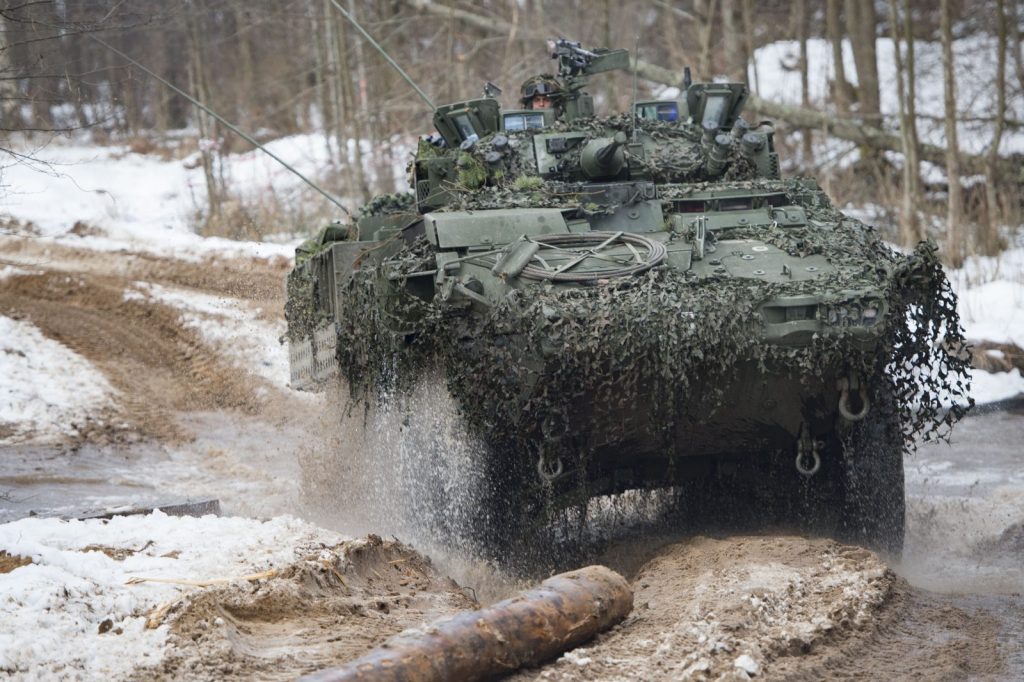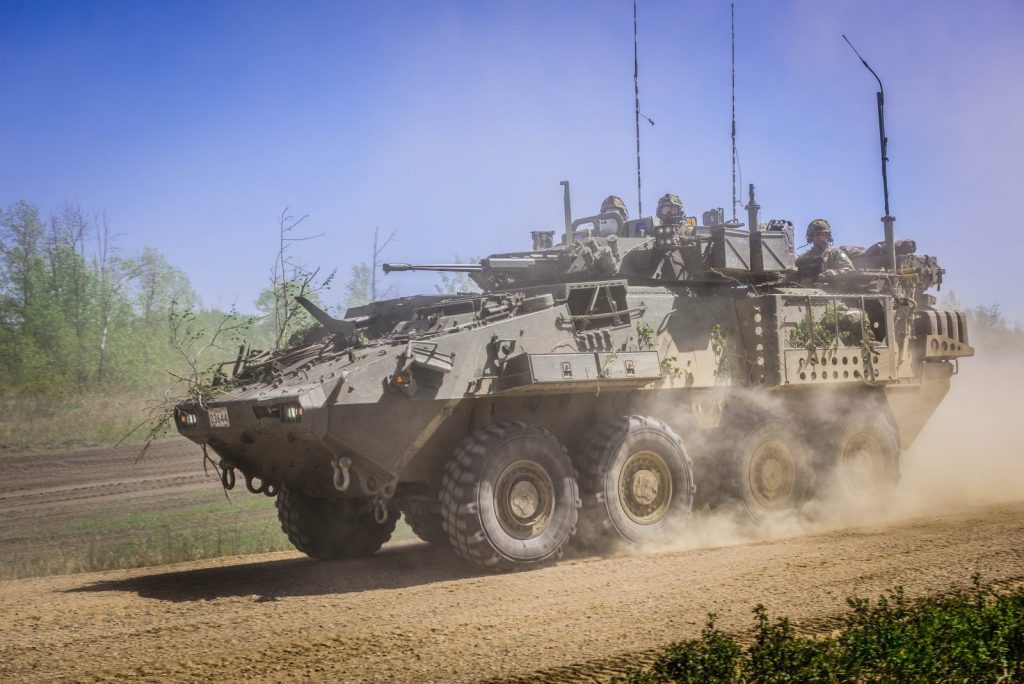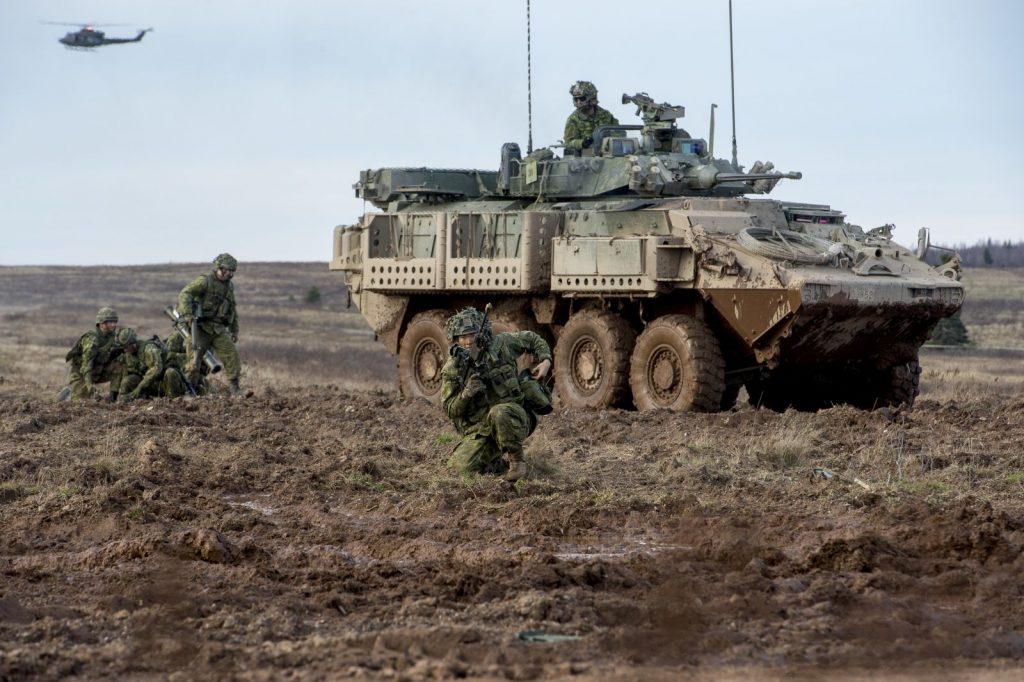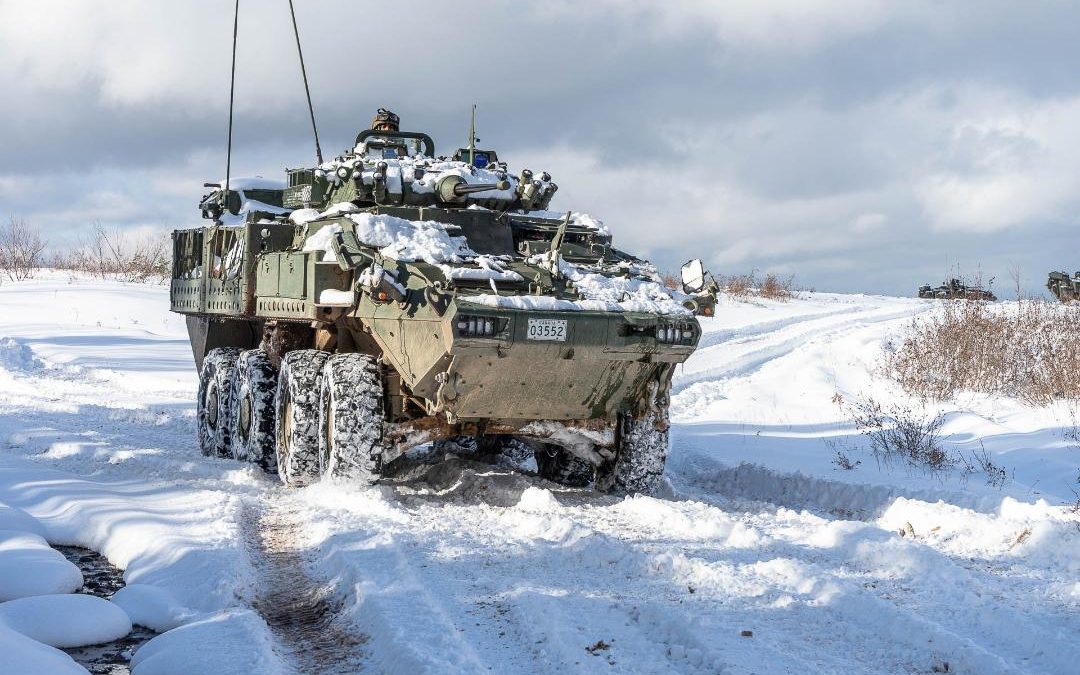By Chris Thatcher
As of the end of April, the last of 550 modernized light armoured vehicles (LAVs) were in the field with Regular Force units across the country. For a program that has seen the scope of work expanded twice, the schedule adjusted several times, and technical changes added even after the vehicles began rolling out in 2013, that’s no small feat.
“LAV UP was a fast project,” said Major Pierre Larrivee, who has led the program since the Army first began analyzing options to upgrade the LAV III to what is now being called the LAV 6.0.
“Whenever you go fast, you sometimes have to retrofit. But [with this project], that has not meant just correcting; it has also enhanced the capability with small improvements,” he explained as he prepares to hand over responsibility from Director of Land Requirements (DLR) to the equipment management team with the Director Armoured Vehicle Program Management (DAVPM).
General Dynamics Land Systems-Canada (GDLS-Canada) was first awarded a contract in October 2011 to upgrade 409 of the Army’s 651 LAV III armored personnel carriers in four variants: an infantry section carrier, a command post, an observation post, and an engineer vehicle. That was later expanded on Feb. 17, 2017 by 141 vehicles to 550.
In November 2012, a contract option was exercised to upgrade an additional 66 configured for reconnaissance and surveillance under the acronym LRSS UP. Though it is a separate project, many of the upgrades overlap. In total, the value of the LAV upgrade project is estimated at over $1.5 billion.
“We have nearly completed production of the second phase (141) of the LAV upgrade,” said Doug Wilson-Hodge, a former reserve armoured corps officer and manager of corporate affairs, “and we are in the qualification phase with LRSS.”
The LAV 6.0 is a refinement of the lessons gained from a decade of experience in Afghanistan and elsewhere. Over 350 of its predecessor, the LAV III, were damaged during the mission, three dozen beyond repair, from small arms, rocket-propelled grenades, and improvised explosive devices.
To develop the mandatory requirements, the project team drew from more than 1,600 lessons learned since the LAV III was first introduced in 1999, including 300 interviews with crew commanders, gunners, drivers and maintenance technicians to identify 700 improvements.
“We looked not only at the technical aspects, but also the TTPs (tactics, techniques and procedures), the way the vehicle was being used,” Larrivee explained in an interview in 2014. “We also looked at what was being developed on newer vehicles.”
The result was what he called a “perfect triangle” of protection, mobility and lethality with the electronic architecture to integrate into a digitized network as part of the Army’s future concept of adaptive dispersed operations.
Though it was labeled an upgrade project, little of the original LAV III remains. The LAV 6.0 addressed protection with a double-V hull with energy attenuated seating; mobility with a new suspension and driveline and a more powerful 450 horsepower Caterpillar engine and larger Michelin tires; and lethality through improved turret components and layout.
What was retained, in addition to the 25mm M242 Bushmaster automatic cannon, turret drive, heater, and automatic fire suppression system, are the core design elements and functionality that have made the LAV the backbone of the Army’s combat vehicle fleet.
Perfecting that triangle, however, was no easy task. Enhanced armoured protection with the same mobility meant a larger vehicle. The baseline weight of the LAV III that deployed to Afghanistan was about 36,000 pounds – it surpassed 42,000 with add-on armour. After the Army added new belly and side armour, an enhanced weapon station and attenuating seats as part of the LAV Operation Requirement Integration Task (LORIT) program in 2009 to address the threat of IEDs, the vehicle weighed in at 52,000 pounds with personnel and kit piled on.
The LAV 6.0 begins at a baseline weight of 45,000 pounds and increases to 63,000 with the full combat package of added armour protection and ammunition.
As the gross vehicle weight grew, though, GDLS-Canada had to enhance the suspension and drive train. “That combined to produce a vehicle that was in a much heavier weight class,” acknowledged Steve Child, senior engineer for product and technology development. “We then started looking at how to redistribute the weight in the vehicle to better support the loads and to move the platform in terms of functionality for both weapons and protection systems.”
The primary weapon on the LAV 6.0 is the M242 Bushmaster, capable of firing the NATO standard 25mm round, and two four-tube smoke grenade launchers. It also has a coaxial 7.62 mm machine gun and a 5.56 mm machine gun located on the roof.

Photo: Cpl Jean-Roch Chabot
INTEGRATED PROCUREMENT TEAM
Few know the LAV better than Larrivee. He was the first officer to be LAV III and technical staff qualified and, since joining DLR in 2001, has overseen the development of requirements for the engineer variant, LORIT and LAV 6.0 projects.
Though there have been trade-offs throughout the project, he believes the Army “received what we asked for [and that] the user opinion was respected.”
That’s in part because the requirements writers in DLR, the vehicle maintainers in Land Equipment Program Management, and the acquisition experts in Public Services and Procurement Canada share common office space as an integrated team, a rarity in defence procurement.
“That’s a strength. I don’t have to run for my contract people,” said Larrivee, noting that the DLR team also stays engaged with the LAV throughout the procurement cycle, from the identification to obsolescence phases of acquisition. “That is how we were able to go so fast.”
He’s read the online blogs and heard the criticisms from soldiers about aspects of the LAV but said in many cases, problems were the result of operator or technician error, often from lack of experience with the platform.
But he’s also been an observer of numerous competitions where the LAV was offered to other countries, and he firmly believes that while other manufacturers may offer larger vehicles with more capability in certain conditions, the LAV 6.0 brings the best overall balance. That triangle of protection, mobility and lethality “is top notch,” he said. “The human factors engineering on the LAV is better than other [vehicles] I saw.”

Photo: MCpl Malcolm Byers
FLEXIBLE ELECTRONIC ARCHITECTURE
GDLS-Canada itself calls the LAV a rolling example of its investments in research and development. In fact, the LAV 6.0 began as a demonstrator called the LAV H. The company had been conducting research on mobility, protection, vetronics and firepower, gathering its own lessons on emerging threats from the conflicts in Afghanistan and Iraq.
“We started to realize that just doing R&D updates and reviews wasn’t enough,” said Child. “We elected to build a demonstrator that combined a lot of the technologies we were looking at so that armies could feel the product rather than just see it in a presentation.”
One of the primary drivers of that R&D was the electronic architecture, understanding how to better integrate systems within the vehicle and then communicate data. Though the LAV 6.0 is not a paragon of vetronics, “we were able to get enough hooks for componentry in the vehicle that we can now build off of that into a much more flexible architecture that will allow for upgrades of the system,” said Child.
As an example, the Army is gradually integrating Capability Pack TOPAZ into the LAV 6.0 as part of its Land Command Support System life extension project. CP TOPAZ is the new computer hardware and tactical battlefield management software that will allow vehicle crews to share positional and other information among themselves and communicate with higher battle group or brigade headquarters. It wasn’t ready when the first vehicles rolled off the production line in London, Ont., in 2013, but GDLS-Canada installed the wiring and space for cabinetry in anticipation.
“Most customers are introducing more sensors into their vehicles, so we have focused R&D on data distribution and presentation,” said Child. “We are starting to work at how to manage higher volumes of sensor and other information and present it in a manner that is meaningful and timely for the crew.”
That includes investment in systems with greater autonomy to reduce the crew’s visual and cognitive loads, such as “camera systems that allow operators to stay under armour as long as possible with high resolution displays, or easy to navigate menu systems and warning systems that don’t overload what a driver has to do when driving,” he added.
At the same time, customers are also insisting on the ability to operate when access to sensor feeds, networks and GPS is limited or denied, observed Joe Nugent, a former Corps of Royal Canadian Electrical and Mechanical Engineers officer and senior engineer for product and technology development. “They want to get the full capability out of the technology when they have it, but they always want a reversionary mode.”
Though it wasn’t part of the original Canadian Army LAV 6.0 requirements, GDLS-Canada is also monitoring evolving Army doctrine to ensure the LAV has the capabilities to operate in urban environments and to work with and defend itself from unmanned systems.
“Urban operations is one of the security environments Canada and other customers have a focus on,” said Nugent. “It is really a combination of situational awareness capabilities that are unique to that environment and also the agility to move around in the battlespace.”
He added: “We are continuously scouting technology for potential applications to help our customers meet the challenges they see in the future. We also do some of our development as hands-on exercises, where we put together concepts and test them … so that we can quickly understand what’s a good idea and what’s just an idea.”

BETTER BATTERIES
Larrivee, for one, hopes one of those tests can solve his biggest concern: battery technology and power consumption. “We are consuming a lot of batteries,” he said, noting that the current battery life of a battery is about three years, which does not meet the demands of modern operators.
In part, that’s because soldiers recharge phones and other devices from one of the two outlets at the rear of the LAV 6.0.
But it’s also a result of tactics. In a typical attack in a training exercise, a LAV might drive a short distance and then go into silent watch for 30 minutes. “You can’t expect to do that repeatedly over three days,” said Larrivee. “The batteries are not charging.”
The problem is only going to get worse as the Army introduces electronic counter measures to the LAV and integrates CP TOPAZ with its dismounted soldier system network. One assessment conducted for the Integrated Soldier System Suite project found that “their power requirement was nearly 20 percent of the vehicle,” he noted.
Projects such as the LAV reconnaissance and surveillance suite upgrade are investigating a battery pack based on a lithium alloy, but that could contribute to another problem the Army is trying to address — electromagnetic interference. “The more we plug in, the more we emit,” he observed, and the electronic signature of the vehicle is a growing concern.
GDLS-Canada identified power consumption as an issue early on and increased power generation in the LAV 6.0 with a larger alternator system. Child said while they focused on “how to distribute that power around the vehicle in a flexible and upgradable manner,” more energy-related R&D projects are being conducted.
Both the company and the Army are exploring the role of health usage and monitoring systems (HUMS). As a first step, the Army is installing a data logger on some vehicles that will be downloaded at regular intervals. It’s not real-time maintenance data, but it will provide technicians with more information about the vehicle. Whether that becomes a full HUMS capability will depend. Cyber security is paramount, Larrivee noted, and the “LAV is the platform of choice for cyber research.”
What the LAV has pioneered, others have capitalized on. Elements of the double V mine-blast resistant hull, the suspension structure, and the electronic architecture have all been leveraged for the U.S. Army’s Stryker combat vehicle upgrade program.
Now, with almost 550 of the LAV 6.0 delivered, including five in an Air Space Coordination Centre variant, and 66 of the reconnaissance and surveillance vehicles pending, GDLS-Canada is eyeing the next opportunity.
“We would like to expand the family of vehicles that exists now with more variants,” said Dean Tremblay, a former armoured corps officer and the company’s Canadian regional manager of business development.
That could include a new ambulance capability, an electronic warfare vehicle, a ground-based air defence system, or any other multirole variant the Army might require. When you have a rolling R&D platform like the LAV, you can manufacturer to the mission.


How many lav 3 are being brought up to lav 6 standards?
The new LAV 6.0 are new made, new hulls, suspension, engine etc…. All old LAV III hulls are stripped for useable parts, and the “shells” are now showing up across Canada as monuments,
In total there will be 621 LAV 6.0 vehicles planned to be delivered currently.
Are you still using the old SS-KTP Tire Repair KIT ?
There is a new State of Art BII from the Battle Damage Assessment Repair, (BDAR Kit)
for all STRYKER Platforms, which repairs more than just the tire. PN; SS-KTPXB,
NSN 5180-01-542-8146.
V/R
Joseph Richards Sr
SAFETY SEAL GC
Adm. R/D, Supply, Tech Support
Cell 903-882-0005; Fx 903-882-0015
safetysealjr@suddenlink.net
http://www.safetysealkitsgc.com
GSA/GS-07F-0128M; Global Supply/MIL/STRIP, DLA, Cage Code 1UFE8
“We are committed to Your Mission…whether in COMBAT,
on the BASE, at the FORT, in the FIELD, and on the BORDER.”
Our CAF Army needs LAV armed autocannon medium calibres 30mm & 35mm, anti-material role/anti-vehicle role, anti-mass personnel role, plus some variants with radar radome & E/O sensors in SPAAG role counter-air….then 76mm high velocity calibre fire support anti-fortification/bunker role. Land force multipliers for CT-COIN and Peer vs Peer Warfare.
Britain, France, etc already have new CTA 40mm, USA new 50mm, Russia has new 57mm with precision guided ordnance.
a lav whit track should be good in the north